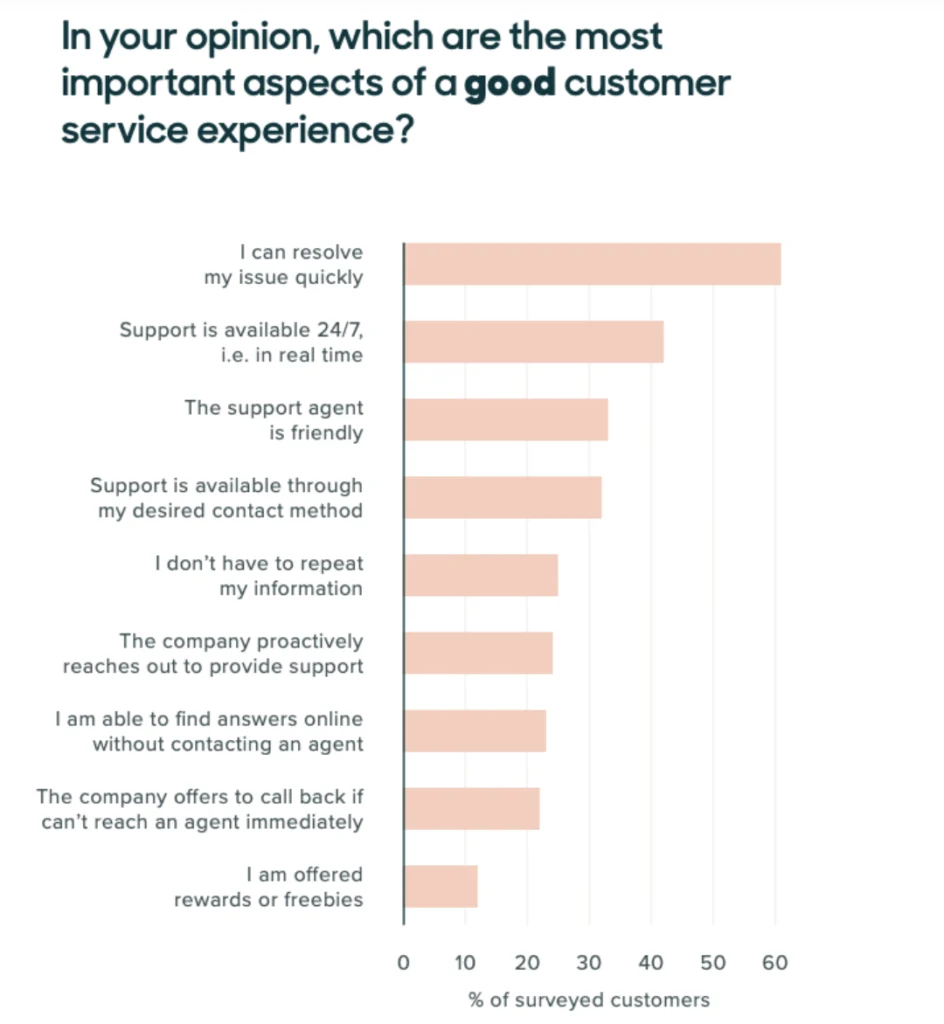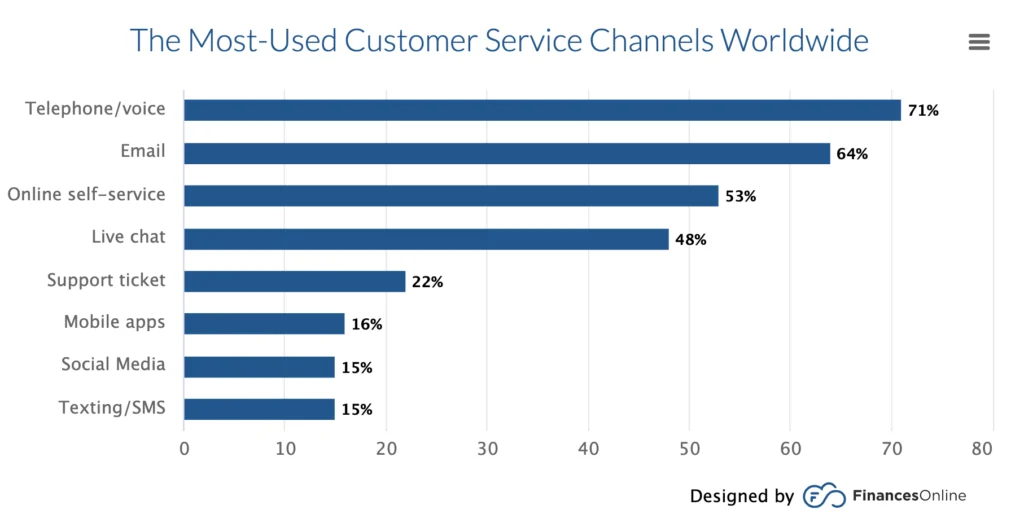The Ins and Outs of Ecommerce Customer Service
Ecommerce is soaring, with over half of internet users buying something online each week. The more customers purchase online–the more ecommerce brands need to adapt their ecommerce customer support to service all those customers.
Is your brand ready to tackle the continued boom in ecommerce in 2023?
Dive into six tips and best practices to help your brand stay on top of the ecommerce customer experience over the next few years.
Key Takeaways:
- A positive customer service experience leads to greater brand loyalty
- Keep the customer at the center of the experience by understanding each customer through customer data
- Outsource your customer service to relief the pressure of keeping up with the high demands of ecommerce customers
What Does Ecommerce Customer Service Encompass?
Ecommerce customer service is help customers receive when they have questions about an ecommerce brand. Customer service is for before, during, and after purchasing a product to guide the customer in making informed decisions and address all concerns.
Customer service includes inbound customer support, which is support for specific products and services. Support addresses issues and questions related to products and how to use the product. For example, a customer might contact customer service to ask what products are best for their needs, while another customer would contact ecommerce customer support if the products aren’t working correctly.
Why Is Customer Service Important for Ecommerce Brands?
According to 90% of consumers, customer service is a significant factor in which brands the customer is loyal to. Loyal customers are the backbone of a healthy ecommerce business as they make up most of the sales. In addition, attracting new customers is 25% more expensive than retaining loyal customers.
If customers have a positive experience, 89% are more likely to make a repeat purchase. However, 58% will switch brands because of poor customer service.
One of the most significant challenges of ecommerce customer service is the lack of face-to-face contact. In-person customer service has multiple channels for communication. The agent can read body language and tone of voice and speak directly with the customer. Unfortunately, ecommerce customers silently slide into an ecommerce shop. Then, they can leave just as quietly without leaving behind any obvious trail of what they wanted or why they didn’t make a purchase.
However, technology is giving ecommerce brands new opportunities to provide additional channels to communicate with customers. This allows you to see and understand more customers, so their visits to your ecommerce stores aren’t so silent.
What Are the Elements of Quality Customer Service?
What does quality customer service that attracts loyal customers look like?
Here are four elements of excellent customer service:
- Customer-centric: Keep the customer at the center of customer service
- Efficient: Answer customer inquiries quickly
- Knowledgeable: Understand the brand and what products are available
- Personalization: Understand the customer and their unique needs

Image from Zendesk Blog
6 Tips to Build a Quality Ecommerce Customer Service Experience
Use these six tips to build an ecommerce customer service experience that will encourage greater customer loyalty.
1. Stay Customer-Focused
The heart of customer service is the customer. Ultimately, customer service aims to find the best solution for the customer’s problem and resolve the issue in as few interactions as possible.
Customer data helps customer service agents understand customers, past interactions, and needs. For example, an agent could make product recommendations based on what products the customer has already purchased. The customer also won’t have to repeat as much information to each agent if customer service agents have access to a library of data that includes past interactions.
Staying customer-focused also means treating each customer like a person rather than a transaction. Being friendly, relating to the customer, and taking time to listen all help the person feel heard and leads to a more positive experience.
2. Equip a Team of Knowledgeable Agents
According to customers, the top characteristic of good customer service is a quick resolution to issues. However, that doesn’t always happen when customer service agents don’t understand the issue or aren’t sure how to resolve a problem.
Train your team of customer service agents, so they understand the brand, products, and how to resolve issues, so customers leave more satisfied.
3. Use Automation and Self-Service Options
Customers prefer self-service options as they can skip the long hold times and avoid talking to a representative over the phone. Self-service also relieves a burden from your agent’s shoulders as more customers can find their solutions so your agents can focus on those that call.
Self-service can come in many forms. Some examples include:
- Automated phone menus
- Live chatbot
- Frequently Asked Questions pages
In addition, 91% of customers said they would use an online knowledge library of resources for answers. These resources allow online shoppers to receive immediate answers just like an in-person shopping experience.
4. Use Social Listening
Social media ecommerce is rising in popularity, with over half of Gen Z making purchases via their social media apps. Shopping is just one way customers interact with brands through social media. Consumers also leave comments and discuss their favorite (or least favorite) brands.
Social listening is tapping into these conversations, so you know what others say about the ecommerce brand and industry. Social listening on one of the largest ecommerce platforms helps your brand understand what consumers expect and want so you can offer a customer service experience closer to what they would receive in a store.
Social listening will also alert you to positive and negative customer comments. Then, your team can respond to those comments to show your brand is actively interested in customer satisfaction.
5. Build a Multi-Channel Approach
Customers prefer multiple channels for accessing customer service agents. The three most popular channels include telephone, email, and self-service.
You can also offer social media, texting, chat, and company apps. Each options is another way for reaching and engaging with customers who need support in a method that is convenient for them.

Image from FinancesOnline
6. Measure Customer Service
How can you know whether you have attained satisfactory customer service?
One customer service metric to use is the customer satisfaction score. Customer satisfaction is the percentage of customers satisfied with their experience compared to the total number of customers. You can send surveys, ask for ratings, and monitor online comments to find your customer satisfaction rate.
You can also look at individual metrics. For example, you can monitor your call center metrics to see how many agents were able to resolve questions in the first call or how long it took to respond to each new inquiry.
Use the results of these metrics to track your customer service growth and ensure you consistently provide a positive experience.
Outsource Your Customer Service
As customer demands increase, ecommerce brands are struggling to keep up with high customer service expectations. Televerde wants to relieve that pressure by offering customer service options. Our teams of highly trained, friendly, and knowledgeable staff are ready to meet your customer’s needs and create a positive experience.
Contact us to learn more about our customer service solutions.


